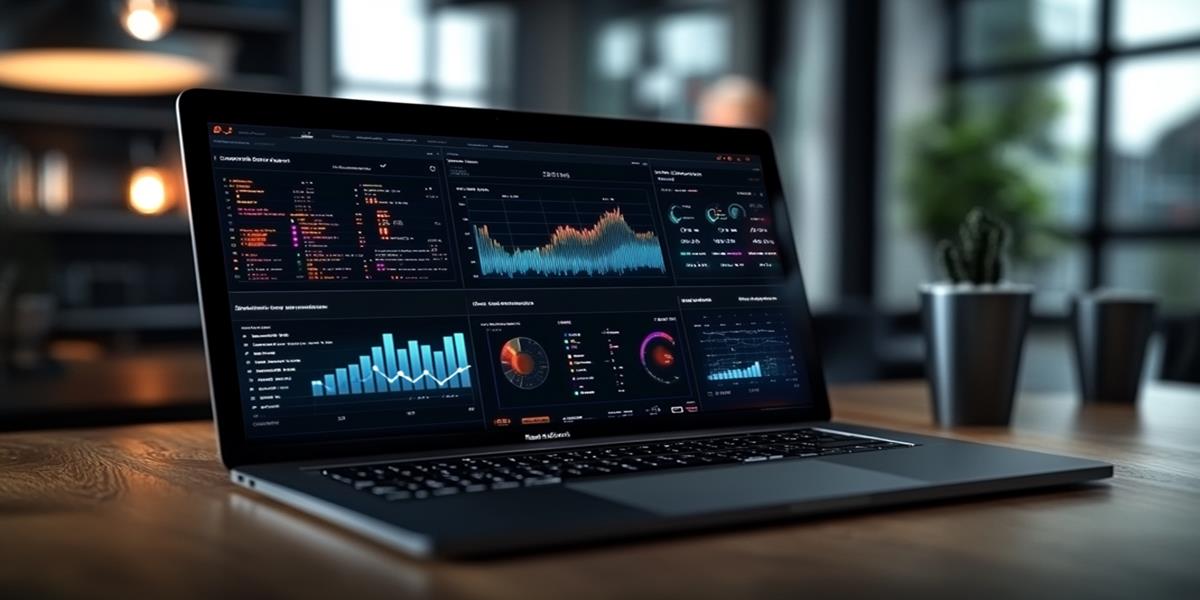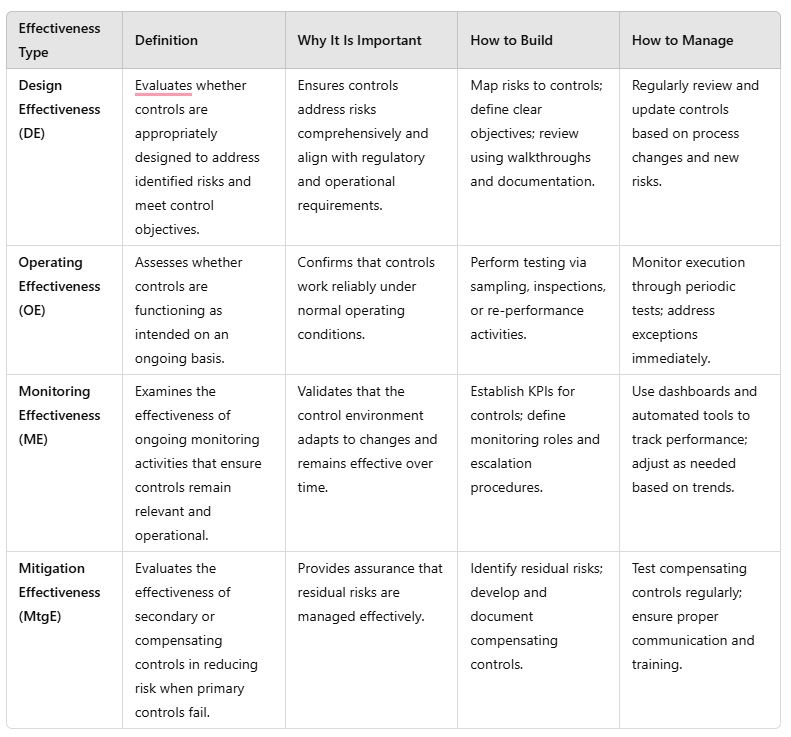Understanding ICIF Control and the Different Effectiveness Types
What is the difference between effectiveness types in ICIF? Find out how Design, Operating, and Monitoring Effectiveness work together to build resilience.
The primary effectiveness types include Design Effectiveness (DE), Operating Effectiveness (OE), and others such as Monitoring Effectiveness (ME). Each serves a unique purpose in the overall assessment of controls.
In this article, we will break down these effectiveness types, explain their significance, provide guidance on how to develop and manage them, and explore practical ways to ensure ICIF controls remain robust.
The Effectiveness Types: Key Differences
Here is a comparative table summarizing the different effectiveness types:
Breaking Down the Key Effectiveness Types
1. Design Effectiveness (DE)
Design Effectiveness ensures that controls are properly structured to address specific risks and achieve their intended objectives. Controls that are poorly designed, even if executed flawlessly, will fail to mitigate risk.Example: A control to prevent unauthorized transactions might involve dual authorization. If the authorization thresholds are poorly defined, the control design is ineffective.
Practical Tips:
- Start with a thorough risk assessment to identify key risk areas.
- Align controls with financial reporting objectives (e.g., accurate journal entries or proper segregation of duties).
- Use walkthroughs to verify if controls cover all aspects of the risk.
2. Operating Effectiveness (OE)
Operating Effectiveness determines if controls are functioning as designed. This evaluation requires real-world testing to verify that employees are consistently implementing controls.Example: A control requiring manager approval for expenses over $5,000 may fail if managers routinely skip the review or approve without scrutiny.
Practical Tips:
- Use random sampling to test controls across various periods.
- Document exceptions and trace root causes to implement corrective measures.
- Engage internal auditors to provide an independent assessment.
3. Monitoring Effectiveness (ME)
Monitoring Effectiveness focuses on whether organizations are continually evaluating and improving their controls. It ensures that no material weakness persists over time due to negligence or lack of oversight.Example: Automated reconciliation tools flag discrepancies, but if no one monitors these flags or resolves issues, the monitoring is ineffective.
Practical Tips:
- Create dashboards to track control performance metrics (e.g., reconciliations completed on time, exceptions cleared).
- Schedule periodic reviews of control frameworks, especially after significant changes in business operations.
- Train staff to recognize and escalate recurring issues.
4. Mitigation Effectiveness (MtgE)
Sometimes, risks persist even with primary controls in place. Mitigation Effectiveness ensures that secondary controls are adequate to address these residual risks.Example: A disaster recovery plan may act as a secondary control to mitigate downtime risks due to a primary control (e.g., data backups) failure.
Practical Tips:
- Identify high-priority risks where compensating controls are needed.
- Test compensating controls under various scenarios to confirm they work as intended.
- Document residual risks and communicate them to leadership for awareness and decision-making.
The Relationship Between Effectiveness Types
Each effectiveness type builds upon the others to create a robust control environment.Design Effectiveness lays the foundation by ensuring that controls are appropriately structured to mitigate risks. Without a sound design, other effectiveness types will fail.
Operating Effectiveness verifies that these well-designed controls are executed properly, while Monitoring Effectiveness ensures that controls remain relevant and adapt to changing circumstances.
Finally, Mitigation Effectiveness provides a safety net when primary controls fail.
By understanding this interplay, organizations can develop a layered defense system that strengthens overall resilience.
Common Challenges in Evaluating Control Effectiveness
Organizations often encounter several challenges in assessing control effectiveness, including:- Inconsistent Documentation: Poorly documented controls make it difficult to assess their design or operation.
- Over-Reliance on Manual Processes: Manual controls are more prone to error and require additional resources to monitor.
- Lack of Timely Updates: Controls often fail to adapt to new risks, regulations, or process changes.
- Resource Constraints: Limited budgets and staff can hinder the thorough testing and monitoring of controls.
Real-Life Examples of Control Effectiveness Assessments
Example 1: Retail Company’s Cash Handling ControlsA retail company’s audit revealed that cash handling controls were insufficiently designed, leading to increased fraud risk. By redesigning controls to include dual cash counts and automated reconciliation, they achieved better oversight and reduced discrepancies.
Example 2: IT System Control Failures
A financial institution’s IT controls were deemed operationally ineffective during peak usage periods. Testing revealed insufficient load capacity. By enhancing the IT infrastructure and introducing automated fail-safes, the organization reduced downtime and improved system reliability.
Role of Technology in Control Effectiveness
Technology can significantly enhance the design, implementation, and monitoring of controls by:- Automating repetitive tasks like reconciliations or exception tracking.
- Providing real-time dashboards to monitor control performance.
- Using predictive analytics to identify emerging risks and potential control failures.
How to Prioritize Control Assessments
Not all controls require the same level of scrutiny. A risk-based approach ensures that high-priority controls are assessed more frequently. Key steps include:- Identifying controls critical to financial reporting or operational success.
- Assigning priority levels based on the likelihood and impact of control failure.
- Allocating resources accordingly, ensuring that high-priority controls receive thorough attention.
Integrating Control Effectiveness into Enterprise Risk Management (ERM)
Control effectiveness is a critical component of Enterprise Risk Management (ERM). By embedding control assessments into ERM processes, organizations can:- Align risk mitigation strategies with broader business objectives.
- Identify gaps in control coverage during risk assessments.
- Enhance reporting to stakeholders by linking control performance to organizational risk profiles.
Measuring Success: KPIs for Control Effectiveness
Key performance indicators (KPIs) provide measurable insights into the success of control assessments. Examples include:- Percentage of controls rated effective during evaluations.
- Time taken to remediate control deficiencies.
- Frequency and severity of exceptions flagged by monitoring tools.
The Role of Leadership in Control Effectiveness
Leadership plays a pivotal role in fostering a culture of strong controls. Key responsibilities include:- Setting the tone at the top by emphasizing the importance of controls.
- Allocating resources to ensure effective testing, monitoring, and updates.
- Demanding regular reporting on control performance and acting on findings.
Industry-Specific Considerations
Control requirements vary across industries due to differing risks and regulatory environments. Examples include:- Financial Services: Compliance with SOX and Basel III demands strong internal controls over financial reporting and risk management.
- Healthcare: HIPAA mandates robust controls to safeguard patient data.
- Technology: Focus on IT general controls (ITGC) and cybersecurity measures to protect sensitive information.
Future Trends in ICIF and Control Effectiveness
The field of ICIF and control effectiveness is evolving rapidly due to technological advancements and changing regulatory landscapes. Key trends include:- Increased reliance on AI and machine learning for predictive risk identification.
- Greater adoption of automation tools for testing and monitoring controls.
- Enhanced regulatory scrutiny, requiring more robust and transparent control frameworks.
